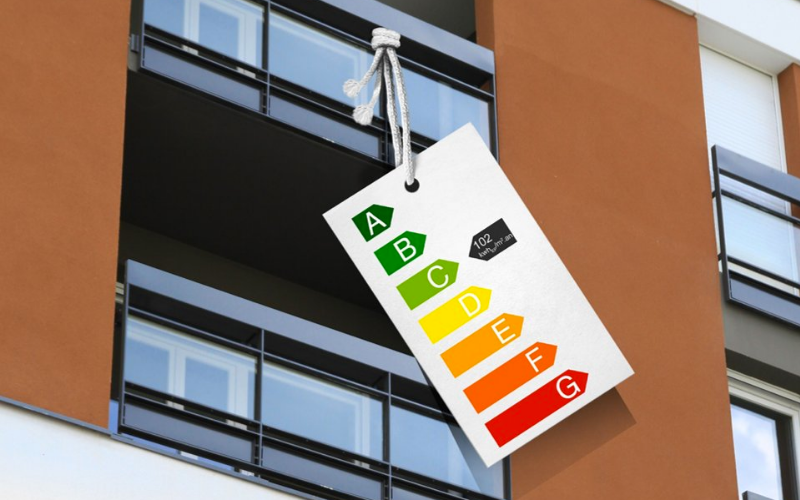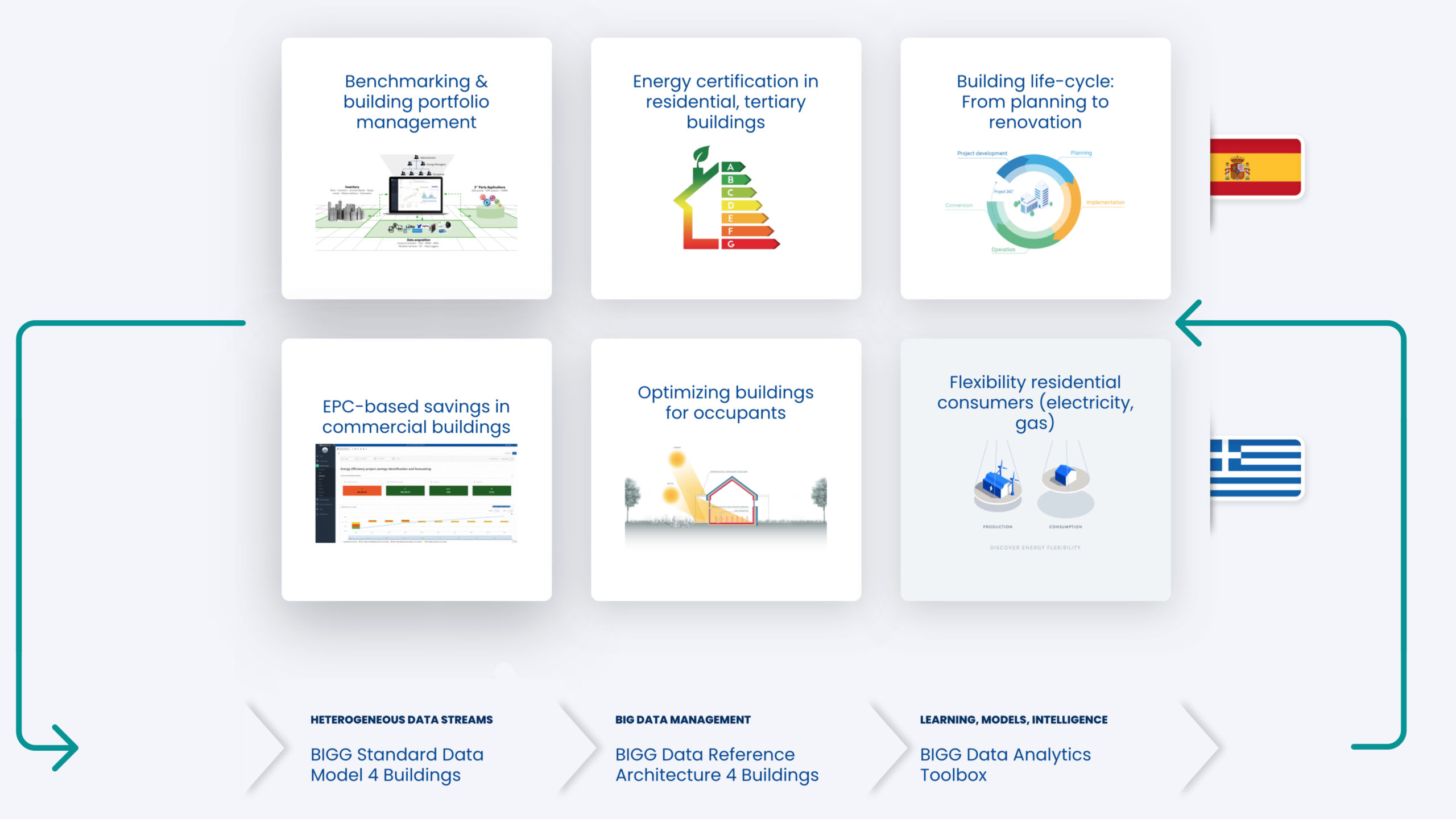The project BIGG (Building Information aGGregation, harmonization and analytics platform), launched in Dec 2020, demonstrates the application of big data technologies and data analytic techniques in the complete buildings life-cycle, in more than 4000 buildings in 6 large-scale pilots, 3 in Spain (Catalonia) and 3 in Greece.
As part of BIGG architecture, the project aims at developing an open, cloud-based building-related data analytics toolbox – supporting different data analysis techniques – extensible to support third party developments and a wide range of services. This Toolbox will be validated in Pilots under following objectives:
- The evaluation of the applicability of the designed BIGG platform to support diverse real-world business scenarios, in terms of defining the KPIs (from technical, business and/or legal perspectives), and collecting monitoring information to check KPIs are met;
- The performance of cross-pilot evaluations of the different business scenarios.
The following picture represents a high-level view of the 6 business cases considered in the BIGG pilots.
This first newsletter focusses on the business cases supported by the Catalan pilots.
BIGG Catalan Pilots Business Cases
The Catalan pilots focus on the needs of the public administrations to enhance the data gathering and analysis for monitoring the performance and improving the energy efficiency of the building stock.
Business Case 1: Benchmarking and energy efficiency tracking in public building
This business case pursues to obtain the greatest value from the energy information, in order to improve the identification of energy efficiency measures in most of public buildings of the Catalonian Government, by monitoring their consumptions. Its main features are:
- Open big data infrastructure for storing all building data in one place and monitor performance.
- Energy benchmarking using data analytics developed in the project.
- Continuous gathering of data from different sources, linked to energy consumption, investments in energy measures, information on users
The main actors identified are around 100 energy managers, responsible for the management of public buildings having a weekly or monthly interaction with the energy management tool, around 20 to 30 policy makers responsible for planning actions to improve the energy performance of buildings with a monthly or bi annually interaction with the tool, and about 10 public authority bodies on special interest on general building trends, having semiannual or annual interaction with the management tool.
The Datasets (provided by some partners) that will be used to facilitate this business case are:
- Basic systems description, energy consumptions and EEM for 4000 public buildings of the Catalan government.
- Monitoring data of 272 Catalan public buildings.
- Equipment inventory, preventive and corrective maintenance actions of these 272 buildings.
- Control data of HVAC systems for 40 public buildings.
- Spanish Municipal data.
This business case consists in two use cases:
Use case – Benchmarking and monitoring of energy consumption
The overall objective is to give to public authorities and energy managers a platform with tools that will help them to manage the energy performance of their public buildings with automated methods. The target is to process a big amount of data from different databases and data sources, to provide with qualified and useful information to improve decision making in buildings energy management, such as:
- Energy performance benchmarking. By normalizing building conditions to be effectively comparable and classified, so that energy managers and public authorities can monitor the energy performance of their buildings and understand why are consuming more or less in similar conditions.
- Trends of building energy performance. Will show the evolution in building performance indicators to trace the energy performance improvement or worsening over time. This will help to evaluate the real impact of energy efficiency measures and to identify and correct worsening situations on a building.
Use case – Energy Efficiency Measures (EEM): registration & evaluation
The objective is to build a structured database to store EEM and evaluate their impact on achieved energy savings from energy consumption data processing.
The expected improvements: to obtain more detailed information on the EEMs involving energy managers by registering the information in a more structured way. It will facilitate:
- Historical information of applied EEMs, reformulating them and mapping the historical data;
- Improve statistical analysis over the registered EEMs to extract more valuable information, that will help to improve the decision making process within the organization;
- Improve the algorithms of EEM savings evaluation.
Business Case 2: Energy Performance Certification (EPC)
The purpose of this business case is to improve the current state of energy certification data:
- By providing an open big data infrastructure to store EPC data and its mapping in an harmonized way;
- By the use and update of data throughout the life-cycle of buildings and not only occasionally, as it is usually the case.
The main actors to be involved in this pilot are policy makers and politicians, who are key in the decision-making process. Other potentially interested actors could be: citizens, insurance companies, financial entities, public entities, administrations, constructors and energy refurbishment companies.
This EPC business case is fed by the following datasets:
- Energy certifications of 1.000.000 Catalan buildings comprising residential and Tertiary buildings.
- Spanish Municipal data

This business case consists, as well, in two use cases:
Use case – Integration of INSPIRE Spatial data to Certification
This use case pretends to harmonize the building EPC with the INSPIRE European Standards. The main objectives are: i) to align countries’ certification information database with INSPIRE scheme’s information, ii) to offer certificates under INSPIRE format and under an open data format, iii) to put in place a 3D Visor for energy certificates accessible to any citizen or any person or company interested and make available correct and useful information in geo-located files with capacity to visualize them in an easy and fast way.
Use case – Sustainable indicators for building certification
This use case seeks to expand the current indicators of the buildings certification, according to the European Level(s) framework. The main objective is to improve the exploration and indicators that can be extracted from the Buildings Performance Certification (BPC) registry by exploring indicators of current BPCs and align them with those marked by Level(s).
Business Case 3: Building Life Cycle, from planning to renovation
The main objective of this business case is to facilitate the interoperability between the different tools and their datasets that can be used during the whole building cycle life.
The interoperability must ensure the data exchange between systems and applications, facilitating the reuse of data between them, reducing the cost of setting and giving more value and new advanced services of data processing for the buildings.
Use case – Interoperability between BIM, BMS, CMMS and building simulation engines
The objective is to guarantee the interoperability between the different data acquisition/generation systems that we can find during the life cycle of the buildings. This interoperability must enable the creation of an integrated value chain across building design, operation, maintenance, commissioning and refurbishment decision-making.
The main actors are building operators, maintenance staff and building managers.
The datasets for the development of this pilot are:
- Equipment inventory, preventive and corrective maintenance actions of 272 public buildings.
- Control data of HVAC systems for 40 public buildings.
- The BIM models for 25 public buildings.

Use case – Interoperability of BIGG with EFFIG-DEEP
The objective is to ensure the interoperability between BIGG platform and De-risking Energy Efficiency Platform (DEEP), by achieving the harmonization of the EEM collected with registers and models existing in DEEP platform, and by establishing the procedures for BIGG and DEEP platforms data exchange.
The actors identified within this pilot are: financial institutions, policy makers and public authorities.
The datasets for this use case are i) the systems description, energy consumptions and EEM for 4.000 public buildings, ii) monitoring data of 272 Catalan public buildings.
Use case – Interoperability between EUBSO and energy Certification hubs through BIGG
The objective of this use case is to ensure the interoperability between the EU Building Stock Observatory (EUBSO) and national/regional EPC hubs through the BIGG platform.
The actors involved in this pilot are managers of the different National Certification Hub’s, politicians and policy makers to improve the decision-making processes provided by the increased value of the data.
The Datasets needed for this use case are i) the energy certifications of 1.000.000 Catalan buildings comprising residential, ii) Tertiary buildings and the Spanish Municipal data.






